‘There’s no place like home’ – 80 Years of The Wizard of Oz
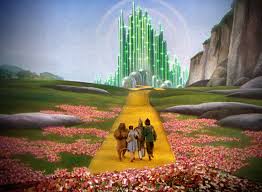
80 years ago in August 1939 a musical fantasy film based on a 1900 children’s book was released in the United States and changed forever the landscape of cinema generally, as well as popularising the genre of make-believe which it both celebrated and augmented. The film in question was Metro-Goldwyn-Mayer’s screen adaptation of The Wonderful Wizard of Oz by L. Frank Baum and, eight decades later, it feels just as original and vibrant as it must have done in 1939. The Wizard of Oz is quite rightly regarded as the greatest fantasy film of all time, but, as is so often the case, this classic was not devoid of its production problems and experienced a great deal of on-set upheaval as it was being made. The stories of its multiple directors and numerous script contributors are well known and the urban legend of a Munchkin suicide has caused many a viewer to freeze-frame at a certain moment during the film’s action. But the praise is pretty much universal to this day and The Wizard of Oz has influenced a host of contemporary film-makers, writers and academics. Writer/director Joel Coen (Fargo, The Big Lebowski, No Country for Old Men) articulated his own personal admiration when he stated quite categorically that ‘Every movie ever made is an attempt to remake The Wizard of Oz.’ Salman Rushdie has referred to the film as his ‘very first literary influence’ and Roger Ebert simply called it ‘a wonderful movie’ as he included it on his list of all-time greats. The sheer magic and remarkable aura of The Wizard of Oz is not bound by time, nor will it ever grow old it seems. And yet it is 80 years since it first became a cinematic sensation. That really is a tremendous and enduring achievement. It’s special place in the hearts of generations of movie-goers is long since assured.
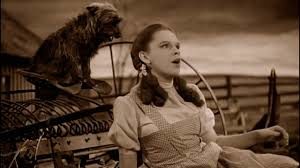
Watching it once again for the umpteenth time, I was reminded of the film’s best qualities and the essential message which it seeks to impart. The opening scenes, which are set in Kansas, will be familiar to all as we are introduced to Dorothy Gale (Judy Garland) and her dog Toto. Living with her Auntie Em (Clara Blandwick) and Uncle Henry (Charley Grapewin) – her parents are never mentioned – Dorothy is a young girl at pains to fend for herself in an adult world. There are no other youngsters that we can see here – or in the land of Oz for that matter – and we may surmise that the teenager has a somewhat isolated existence; sheltered perhaps is the appropriate term. She has an immediate problem too because Toto has been misbehaving himself and incurring the wrath of the local busy-body and woman of purported influence Miss Gulch (Margaret Hamilton). When Dorothy tries to explain her predicament and fear for her beloved dog, she encounters grown-ups who are mostly unlistening and lacking somewhat in empathy. Any adolescent watching the film for the first time will recognise such a situation. It’s a universal experience and part of The Wizard of Oz’s brilliance is the way in which it presents such episodes and relays the common sentiments. When Auntie Em suggests to her that she find herself ‘a place where you won’t get into any trouble’, this is the cue for Garland’s famous and poignant performance of Over the Rainbow. Hard to believe that the studio in this case (MGM) almost had the Oscar-winning song omitted from the final cut of the film; credit to the film’s official director Victor Fleming for fighting to keep it in.
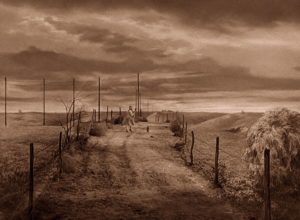
This duly brings me back to the subject of the film’s turbulent production and the handful of directors who played a part in its inception. The original director Richard Thorpe shot approximately nine days of footage before being temporarily replaced by George Cukor. Victor Fleming took over from the My Fair Lady director whom he would then eventually replace on David O. Selznick’s production of Gone with the Wind. In Fleming’s wake, King Vidor picked up the Kansas scenes and some of the Munchkin sequences. The word difficult is not an understatement in the context of the film’s principal photography stage. On-set accidents were commonplace and the Oz scenes were shot in glaring light and soaring temperatures. Margaret Hamilton (who also played the Wicked Witch of the West) was severely burned during the course of a special effect which was intended to signal her character’s exit from Munchkinland. The original actor playing the Tin Man, Buddy Ebsen, was replaced by Jack Haley when he had a dangerous reaction to the silvery makeup employed. Even Terry the dog (Toto) was injured when he was accidentally stepped on during the long and arduous shoot. Most of the cast were required to work six days a week and had to arrive in the wee small hours of the morning for lengthy makeup processes and costume-fitting. Given such problems – which were frequent and considerable – it’s something of a minor miracle that the film got completed at all and subsequently attained the classic status it has enjoyed ever since.
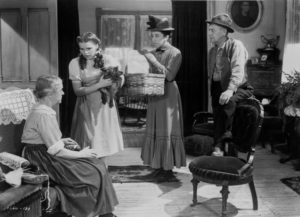
The Kansas prologue and coda which bookend the film were filmed in black-and-white and then coloured in a sepia-tone process. The effect I would suggest is to give these sections a more subdued feel in contrast to the luminous three-strip Technicolor which is such an integral feature of the scenes set in Oz. Let’s also recall the fact that The Wizard of Oz opened nationwide in America in August 1939 when black-and-white pictures were still the predominant format. The aforementioned Gone with the Wind (which would open in December of that same year) was also shot in Technicolor, but such films like it and The Wizard of Oz represented the exception rather than the rule. The monochrome scenes which take place in Kansas serve to emphasise the colour and vitality of Oz which – to Dorothy’s eyes and the viewer’s – is, at once, a highly unusual but visually exciting place. Compare this to the much more sedate setting of Kansas which definitely suggests depression-era America prior to the outbreak of the Second World War. From the audience’s point of view, we fully understand Dorothy’s decision to flee the farm with Toto when Miss Gulch threatens to have him destroyed. The running theme of adults who cannot be completely trusted (even deceptive in some cases) continues as Dorothy encounters Professor Marvel (Frank Morgan). The so-called fortune teller is benevolent, but he sneaks a peek at a picture of Dorothy and her Auntie Em in order to deliver his prognostication. When the hurricane strikes, it’s also notable that the adults descend into the storm shelter whilst Dorothy is left above where she is forced to seek shelter in the house. I’m not suggesting for a moment that this is a deliberate act on their behalf, but it does serve to highlight Dorothy’s sense of isolation in a highly dramatic way.
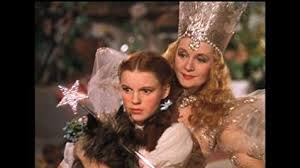
I think most of us can probably remember the first time we watched The Wizard of Oz; it was probably on television as part of the Christmas schedule or on a typically damp Sunday afternoon. If we can recall such an occasion in time – as I can myself – then the film’s enchanting quality is clearly beyond question. In his December 1996 article on the picture, Roger Ebert suggests that much of The Wizard of Oz’s emotional resonance and abiding magic for the viewer arises from the simple fact that the vast majority of us saw it for the first time when we were still quite young. Who can possibly forget that pivotal moment when Dorothy takes her first step from the darkened house into the radiant land of Oz? – ‘Toto, I’ve a feeling we’re not in Kansas anymore…we must be over the rainbow.’ Dorothy’s tentative emergence into this world of wonder and awe is indeed reminiscent of a child discovering a new and curious place. There are amazing and amiable presences to be encountered here, such as Glinda the good witch (Billie Burke) and the Munchkins, but there is also the malevolent presence of the Wicked Witch of the West – ‘I’ll get you my pretty…and your little dog too.’ Upon Glinda’s advice, Dorothy embarks (with her newly-acquired ruby slippers) for the Emerald City where the great and powerful wizard resides – ‘Follow the Yellow Brick Road.’ Dorothy’s personal odyssey is to seek out this mysterious figurehead who appears to have near-divine status; the ultimate objective of the journey is to return to Kansas which our young heroine now positively yearns for.
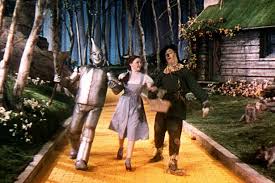
The characters of the Scarecrow (Ray Bolger), the Tin Man (Jack Haley) and the Cowardly Lion (Bert Lahr) whom Dorothy meets on the Yellow Brick Road are – as Roger Ebert suggests – ‘projections of every child’s secret fears.’ Will I be smart enough to last the course? Will my actions have heart and meaning? Will I be brave in the face of adversity? By helping all three of them, Dorothy is ultimately coming to her own assistance and growing up in the process as every child must do. The deficiencies of her new friends (lack of brains, heart and courage) are universal anxieties which most of us have surely had at one time or another. This, I would submit, is one of the main reasons why The Wizard of Oz continues to have such an impact some eight decades after its initial release. What child has never experienced an agitation or distress when he or she was unable to understand something or felt an innate fear? Even as we amble our way through adulthood, a good many of us worry about the sincerity of our deeds, the integrity of our exchanges with others. The life lessons which Dorothy learns on her journey to the Emerald City represent a rite of passage in this regard. In order to return to Kansas, to get home in other words – as her heart desires – Dorothy comes to realise that she must help others who, in turn, can help her. This key message of the film is as just as important today as it was way back in 1939. The late Roger Ebert pretty much nails it when, in his 1996 article, he identifies the importance of home as emphasised by the story. Home represents safety and security; for Dorothy it is her Auntie Em and Uncle Henry and the three farm hands (also played by Bolger, Haley and Lahr) who can offer comfort and protection to varying degrees. A key lesson of childhood in Ebert’s words is that ‘someday the child will not be a child, that home will no longer exist, that adults will be no help because now the child is an adult and must face the challenges of life alone.’ In her apparent dreamlike state, Dorothy’s coping mechanism is to find friends, to win allies. The Scarecrow, the Tin Man and the Cowardly Lion strongly resemble the trio back in Kansas because a familiar face is always a reassuring thing. Points of reference and recognisable features work for us all because they encourage feelings of solace and imply that support is close at hand.
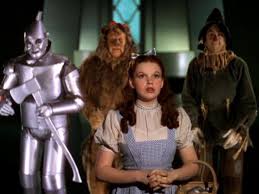
Support is not something which Dorothy receives from the much-heralded wizard at first. Admitted to his inner sanctum, the four friends are clearly intimidated by the booming voice and large ghostly head which is surrounded by fire and smoke. Effusing an exaggerated aura of infinite power and far-reaching dominion, the wizard demands that they bring him the broomstick of the Wicked Witch of the West in exchange for him granting their wishes. The set-back which occurs at this point of the film is, again, part of the story’s instructive design. Sometimes a resolution to a problem appears within one’s grasp before it is dashed away – so near, yet so far. In Dorothy’s particular case, a haunted forest must be traversed and the Wicked Witch’s sinister castle infiltrated. Aficionados of the film will of course remember the famous scene which follows whereby Margaret Hamilton’s character dispatches her legion of flying monkeys to abduct the young girl (which was later spoofed to humorous effect in The Simpsons episode The Last Temptation of Homer). I don’t feel that I need to repeat the episodes which ensue in this section of the film, suffice it to say that the Witch’s demise is also one of the film’s most famous moments (‘I’m melting! Melting! Oh, what a world! What a world! Who would have thought a good little girl like you could destroy my beautiful wickedness?!’). As an aside – and being the movie geek that I am – allow me to suggest that you re-watch 1989’s Field of Dreams and see if you can spot where this particular scene is referenced.
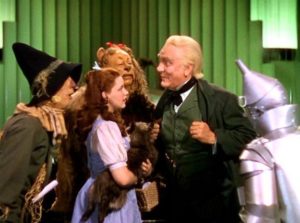
Writing about the film which was his ‘very first literary influence’, Salman Rushdie argues that The Wizard of Oz’s ‘driving force is the inadequacy of adults, even of good adults, and how the weakness of grownups forces children to take control of their own destinies.’ Such a contention gains much traction in the film’s final act wherein the wizard (one of Frank Morgan’s multiple roles) is revealed to be a common man and not a demigod after all. The curtain having literally been pulled back (by Toto no less), the wizard is shown to be something of a charlatan in the vein of Professor Marvel – ‘I’m a very good man, I’m just a very bad wizard.’ Describing himself as ‘an old Kansas man’, the essentially affable gentleman even fails to live up to his promise to transport Dorothy home by means of hot-air balloon (‘I can’t come back. I don’t know how it works’). The reappearance of Glinda the good witch and her assertion that Dorothy ‘always had the power to go back to Kansas’ reinforces Rushdie’s thesis that the child must take control of his/her own destiny. Tapping the heels of her ruby slippers together three times and repeating the words ‘There’s no place like home’, Dorothy is transported back to Kansas/awakens from her apparent bout of unconsciousness. But, importantly, she is not oblivious to what has just happened and can recall every exact detail of where she has been – ‘It wasn’t a dream, it was a place.’ With her Auntie Em, Uncle Henry, Hunk, Hickory, Zeke and a beaming Professor Marvel in close attendance, Dorothy’s recounting of her adventures suggests a state exceeding a normal dream. So was it a fantasy of her mind we ask ourselves. Or a construct of some other kind? Did Dorothy spend time in this other-world? Can a place such as Oz really exist? Make of it what you will (because I personally believe the writers wanted the audience – especially the younger members – to place their own interpretation on this), but consider it reason enough to watch this wonderful film once again.
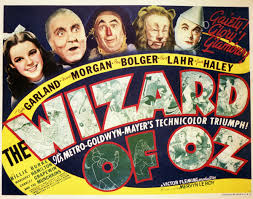
Nominated for five Academy Awards (it lost Best Picture to Gone with the Wind, but won Best Original Score and Best Original Song), The Wizard of Oz was released into a world which would soon witness drastic change with the outbreak of World War II in September of that same year. America did not enter the theater of conflict until after the attack on Pearl Harbor in December 1941 and, at the risk of stretching an analogy here, one could suggest that the neutral country’s decision to remain an outside influence up to that point intimated a desire to focus on matters pertaining to the home front; bear in mind the fact that the USA was just emerging from the Great Depression of the 1930s. There was no place like home until home itself came to be threatened. When that occurred – on the morning of the 7th December, 1941 – America assumed a fully-fledged role in the war and world affairs generally. The more cynical among us would say that, on occasion, she has overstepped this particular mandate. The post-war years were favourable to the fortunes of The Wizard of Oz. The advent of TV served to reintroduce it to a wider audience and also bring it to the attention of the next generation. The film was a ratings success in the latter half of the 1950s and successive releases on home media have sustained its immense popularity. According to the Library of Congress it is the most viewed film in the history of television syndication. No small feat.
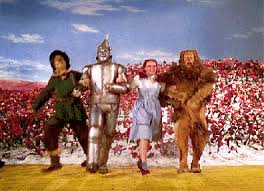
Judy Garland passed away at the much-too-early age of 47 in June 1969. At her funeral in New York, her Wizard of Oz co-star Ray Bolger commented that the late star ‘Just plain wore out.’ Garland’s untimely passing will never detract from the quality of her work in the medium of cinema and the entertainment field generally. Her star shone brightest of all in the 1940s, in the wake of the success of The Wizard of Oz. Her respective co-stars Bolger, Haley and Lahr lived longer lives in contrast; Bolger died at the age of 83 in 1987; Haley at the age of 80 in 1979; and Lahr at the age of 72 in 1967. Frank Morgan – who played the titular part and several other minor roles – was the only principal cast member who did not live to see the film’s resurgence on television in the 1950s; he died at the age of 59 in 1949. The cultural impact of The Wizard of Oz cannot be overstated and it has warmed audiences and influenced film-makers in equal measure over the past eight decades. Just consider the works of distinguished directors such as David Lynch if you don’t believe me – in particular his 1990 Palme d’Or-winning film Wild at Heart which contains several allusions to the 1939 classic. And that’s overlooking the wonderful score by Herbert Stothart and the songs by Harold Arlen and Yip Harburg. I dare anyone not to feel a lump in their throat as Judy Garland delivers that heartfelt performance of Over the Rainbow at an early juncture in the film. It’s one of several hundred magical moments from this timeless classic and more than a good reason to hail it as one of the very best of old Hollywood. Happy 80th birthday The Wizard of Oz. There is no place like home when it involves this truly wonderful motion picture.